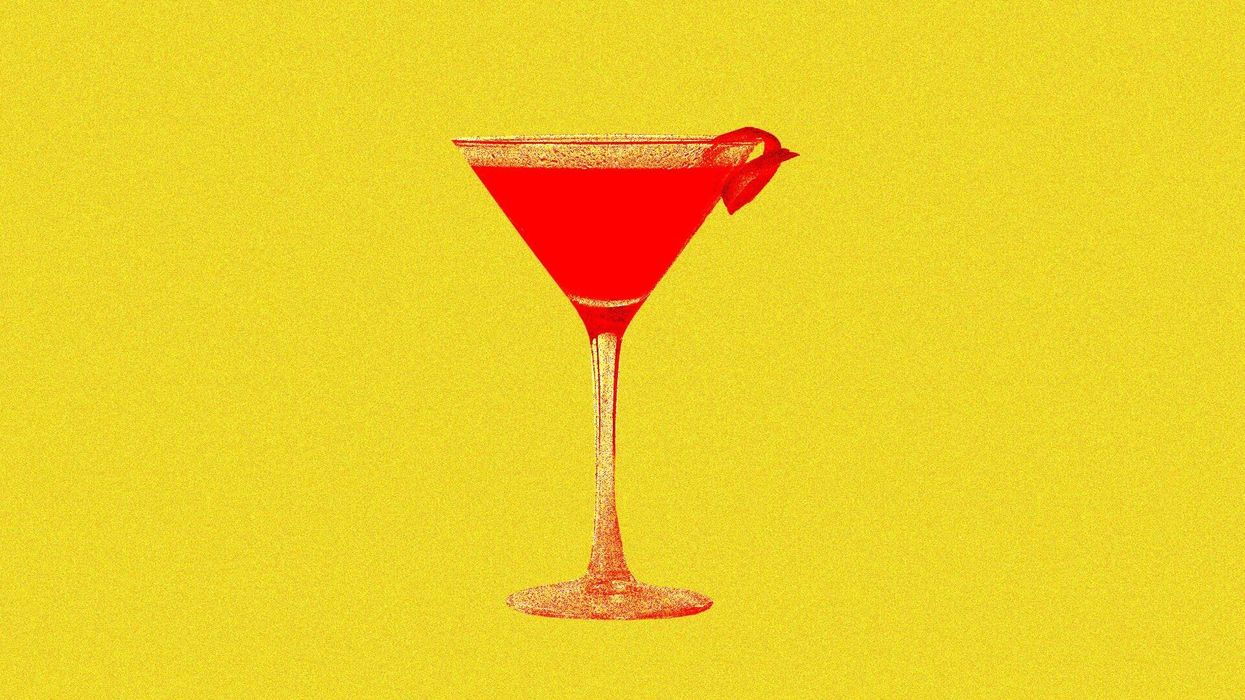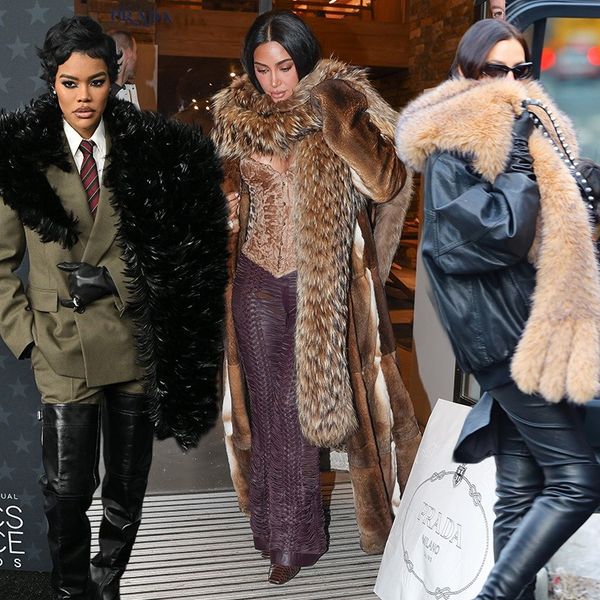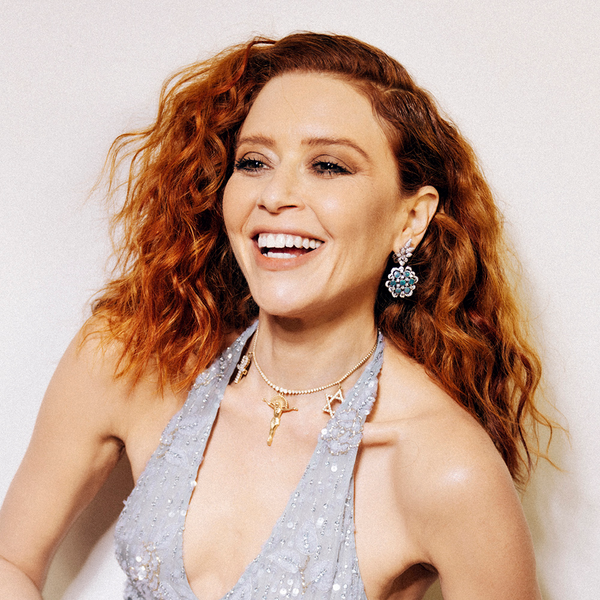A Case for The Cosmo
Bringing back the original girl’s girl cocktail from Sex and the City to be our next drink du jour.

Have you ever had a Cosmopolitan? Likely not recently—since the Cosmo, though a classic, has, over time, become a has-been—shunned by the masses, thrown over for younger, sexier cocktails. Bartenders hate making them, they say. Embarrassing to order, they malign. Cheesy! Overdone! The public vitriol cuts—our overlords are out for blood. Then, they go for the jugular: What, are you from the Midwest?
Lore says the first Cosmopolitan may have been served in the Rainbow Room in the late ‘80s vis-à-vis bartender Dale DeGroff. Others think Cheryl Cook, the Martini Queen of South Beach, invented the pink drink—the lovechild of a Kamikaze and cranberry juice. But most agree the cocktail canon is this: bartender Tony Cecchini created the cocktail at New York restaurant hotspot the Odeon in 1988. As the story goes, an Odeon waitress had just been to San Francisco, where an early Cosmo—then just vodka, Rose’s sweetened lime juice, and syrupy grenadine—was making the rounds. She told this to bartender Cecchini, who made his own version, shaking up the drink we know today— an icy pink froth of vodka, cranberry juice, fresh lime, and Cointreau, served in a thin-stemmed Martini glass or low coupe. Soon, Madonna was drinking them like a fish with actress Sandra Bernhard. Says Cecchini, “They were older than me and called me boyfriend. ‘Boyfriend! Two more of those pink drinks!’”
Global recognition came later in the ‘90s with Sex and the City, a show centered on female friendship between the canonical Carrie, Miranda, Charlotte, and Samantha. The women were often seen with the pink paragon—whether at lunchtime, on a date with Big in a clingy matching pink dress, or passing the Bechdel test together over drinks. It was the fifth girl at the table, a hot pink symbol of modern women. The show’s protagonists were trendsetters, tastemakers, early pre-Instagram influencers in a “I saw Carrie hop-skipping into a bar to order a Cosmo, so I hop-skipped into a bar to order a Cosmo” kind of way.
When I was a little girl, my parents took my brother and me to a Lincoln Center musical. At intermission, my Mom sipped a Cosmopolitan from a short plastic cup tartly garnished with lime. She was a sophisticate; a woman who wore heels everywhere and was never seen without lipstick. When I grew up, I wanted to be her. Later, when I was in college, and I watched Carrie Bradshaw run around Manhattan for the first time, what I’d known since I was ten was proven: The Cosmopolitan was for a New York woman. She had expensive shoes, overpaid for coffee, sat in power booths, and had good friends in high places. Her purse was probably from Barney’s, full of gum wrappers, receipts, and crumpled cab fare. I was going to be her.
At school in New York, I would go to bars and order a Cosmopolitan. I’d pay $30 for a single drink at a hotel bar. With a Cosmo in hand, it felt like trying on a pair of shoes that fit. Perhaps like Midwestern women at Applebee’s, giggling I’m so bad after ordering another frosty hot pink round, it connected me to Carrie, to my Mom. Soon, it became my order—what I’d breezily tell the bartender I’d be drinking at whichever Ritz or Peninsula I’d walked into.
Though I was drinking them, by the time I was—ahem—21, the bloom was off the rose for many. It was the 2010s and the Cosmopolitan, once everywhere—on every cocktail list—had gone the way of the dodo. It was perhaps a guilty pleasure for some, a drink imbibed only by tourists on bus tours to Carrie’s apartment building. Still, I couldn’t help but wonder: the 90s and early aughts are in the zeitgeist, so shouldn’t the original girl’s girl cocktail from Sex and the City be our next drink du jour? Doesn’t everything old become new again and again? If jeans and a nice top can once again carry the night, if And Just Like That can pick up where it left off, why not the Cosmo? After all, you can’t swing a Fendi purse without knocking over a brunch table of Espresso Martinis—a drink that’s recently come back around.
Perhaps the Cosmo is, as modern vernacular limns, cheugy. But calling it untrendy isn’t a good enough reason to not bring it back. After all, aren’t we unironically extolling the virtues of low-rise jeans again? Saying it’s a drink for “basic bitches” is lazy. As Estelle Bossy, the beverage director of Roosevelt Island’s rooftop Panorama Room told Harper’s BAZAAR, “The cosmo itself was never the problem, but our snobbery toward it was.” Truly, God forbid one order a Cosmo, lest TMZ catch you with the glass at your lips. The bartender might then serve you and ask if you want to open a tab!
Bossy went on to say a renewed appreciation for “dated” drinks—the Long Island iced tea, the Midori sour, the Cosmopolitan—came out of Coronavirus quarantines. It’s true: One of its biggest staunch supporters threw their weight behind it in 2020—Ina Garten—who had a very good time with an extravagant fishbowl-sized Cosmo. It’s also purportedly Taylor Swift’s drink—and like it or not, what she says, goes. Aubrey Plaza even publicly endorsed the Cosmo in her recent cocktail campaign for French orange liqueur, Cointreau. All of this to say, maybe the Cosmopolitan is back. Tacky, obvious, whatever pejorative—attitudes change, hate can turn to love, biases can be banished. Do you hear that? That’s the sound of thousands of people gleefully, tipsily adding this Cosmopolitan-shaped Judith Leiber crystal clutch to their carts.
While we sip, let’s also counterclaim the Cosmo’s girly rep—the Pink Drink Stigma, as it were. Yes, it is girly. As we’ve established, this is a girl’s girl cocktail. It gives dating advice at brunch, understands your feminine urges, is a pundit on the pink tax, sees your everything shower, and raises you Nancy Meyers apartments. It knows being a woman is work, too. It gets that shaving and plucking and blowdrying is tedious upkeep, that your tights and mascara will run, that you’ll lose earrings and bobby pins. And it’s strong, like women themselves—seeing you through childbirth, period pain, menopause.
Still, it’s pink and read as prissy. It’s funny, though. I remember being at a bar once with a man, chatting with our bartender about our drink orders—mine, a Cosmopolitan, his an Old-Fashioned. When the bartender began delineating the proportions for the Old-Fashioned to us, I realized—as a drink-slinging hobbyist myself, who has made many Cosmos—that the stout drink of Don Draper, professorial bearded academics, steely titans of industry–had less alcohol. The Cosmo was stronger, harder. After another drink each, I’d practically had three to his two. Yet girly derision, like that of hating the pink walls in your childhood bedroom as a teenager, is still alive. I’d once bad-mouthed pink myself, often to my Mom, who’d just raise an eyebrow and nod dispassionately. What was pink a euphemism for? While I outgrew this, it seems most haven’t—or won’t.
Let’s fix all this. If someone calls you cheugy, obvious, or prissy—but no one’s around to hear it, let alone care—does it matter? A slip of a woman I know makes short work of Old-Fashioneds at happy hour, and my brawny businessman brother knows exactly how to make a Cosmopolitan. The buck stops here: drink what you want. That’s what my Mom and Carrie would do. As for me, I’m having what they’re having. Send me a round, will you?
Want more stories like this?
I Ditched My iPhone for a Flip Phone
Anamaria Morris is Creating All Kinds of Objects
In Defense of Gift Cards




